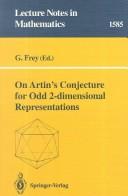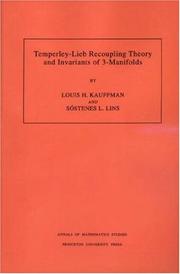| Listing 1 - 4 of 4 |
Sort by
|
Book
Year: 1994 Publisher: Berlin ; New York ; Tokyo Springer-Verlag
Abstract | Keywords | Export | Availability | Bookmark
 Loading...
Loading...Choose an application
- Reference Manager
- EndNote
- RefWorks (Direct export to RefWorks)

ISBN: 3540583874 354048681X 9783540583875 Year: 1994 Volume: 1585 Publisher: Berlin Springer
Abstract | Keywords | Export | Availability | Bookmark
 Loading...
Loading...Choose an application
- Reference Manager
- EndNote
- RefWorks (Direct export to RefWorks)
Number theory --- Artin's conjecture. --- Forms, Modular. --- Functions, Zeta.
Book
ISBN: 0691036810 0691036756 1400882540 9780691036755 9780691036816 Year: 1994 Volume: 133 Publisher: Princeton (N.J.): Princeton university press,
Abstract | Keywords | Export | Availability | Bookmark
 Loading...
Loading...Choose an application
- Reference Manager
- EndNote
- RefWorks (Direct export to RefWorks)
Written for advanced undergraduate and first-year graduate students, this book aims to introduce students to a serious level of p-adic analysis with important implications for number theory. The main object is the study of G-series, that is, power series y=aij=0 Ajxj with coefficients in an algebraic number field K. These series satisfy a linear differential equation Ly=0 with LIK(x) [d/dx] and have non-zero radii of convergence for each imbedding of K into the complex numbers. They have the further property that the common denominators of the first s coefficients go to infinity geometrically with the index s. After presenting a review of valuation theory and elementary p-adic analysis together with an application to the congruence zeta function, this book offers a detailed study of the p-adic properties of formal power series solutions of linear differential equations. In particular, the p-adic radii of convergence and the p-adic growth of coefficients are studied. Recent work of Christol, Bombieri, André, and Dwork is treated and augmented. The book concludes with Chudnovsky's theorem: the analytic continuation of a G -series is again a G -series. This book will be indispensable for those wishing to study the work of Bombieri and André on global relations and for the study of the arithmetic properties of solutions of ordinary differential equations.
Analyse p-adique --- H-fonction --- H-functie --- H-function --- p-adic analyse --- p-adic analysis --- H-functions --- H-functions. --- p-adic analysis. --- Analysis, p-adic --- Algebra --- Calculus --- Geometry, Algebraic --- Fox's H-function --- G-functions, Generalized --- Generalized G-functions --- Generalized Mellin-Barnes functions --- Mellin-Barnes functions, Generalized --- Hypergeometric functions --- Adjoint. --- Algebraic Method. --- Algebraic closure. --- Algebraic number field. --- Algebraic number theory. --- Algebraic variety. --- Algebraically closed field. --- Analytic continuation. --- Analytic function. --- Argument principle. --- Arithmetic. --- Automorphism. --- Bearing (navigation). --- Binomial series. --- Calculation. --- Cardinality. --- Cartesian coordinate system. --- Cauchy sequence. --- Cauchy's theorem (geometry). --- Coefficient. --- Cohomology. --- Commutative ring. --- Complete intersection. --- Complex analysis. --- Conjecture. --- Density theorem. --- Differential equation. --- Dimension (vector space). --- Direct sum. --- Discrete valuation. --- Eigenvalues and eigenvectors. --- Elliptic curve. --- Equation. --- Equivalence class. --- Estimation. --- Existential quantification. --- Exponential function. --- Exterior algebra. --- Field of fractions. --- Finite field. --- Formal power series. --- Fuchs' theorem. --- G-module. --- Galois extension. --- Galois group. --- General linear group. --- Generic point. --- Geometry. --- Hypergeometric function. --- Identity matrix. --- Inequality (mathematics). --- Intercept method. --- Irreducible element. --- Irreducible polynomial. --- Laurent series. --- Limit of a sequence. --- Linear differential equation. --- Lowest common denominator. --- Mathematical induction. --- Meromorphic function. --- Modular arithmetic. --- Module (mathematics). --- Monodromy. --- Monotonic function. --- Multiplicative group. --- Natural number. --- Newton polygon. --- Number theory. --- P-adic number. --- Parameter. --- Permutation. --- Polygon. --- Polynomial. --- Projective line. --- Q.E.D. --- Quadratic residue. --- Radius of convergence. --- Rational function. --- Rational number. --- Residue field. --- Riemann hypothesis. --- Ring of integers. --- Root of unity. --- Separable polynomial. --- Sequence. --- Siegel's lemma. --- Special case. --- Square root. --- Subring. --- Subset. --- Summation. --- Theorem. --- Topology of uniform convergence. --- Transpose. --- Triangle inequality. --- Unipotent. --- Valuation ring. --- Weil conjecture. --- Wronskian. --- Y-intercept.

ISBN: 0691036411 0691036403 1400882532 9780691036403 9780691036410 Year: 1994 Volume: 134 Publisher: Princeton, N.J. Princeton University Press
Abstract | Keywords | Export | Availability | Bookmark
 Loading...
Loading...Choose an application
- Reference Manager
- EndNote
- RefWorks (Direct export to RefWorks)
This book offers a self-contained account of the 3-manifold invariants arising from the original Jones polynomial. These are the Witten-Reshetikhin-Turaev and the Turaev-Viro invariants. Starting from the Kauffman bracket model for the Jones polynomial and the diagrammatic Temperley-Lieb algebra, higher-order polynomial invariants of links are constructed and combined to form the 3-manifold invariants. The methods in this book are based on a recoupling theory for the Temperley-Lieb algebra. This recoupling theory is a q-deformation of the SU(2) spin networks of Roger Penrose. The recoupling theory is developed in a purely combinatorial and elementary manner. Calculations are based on a reformulation of the Kirillov-Reshetikhin shadow world, leading to expressions for all the invariants in terms of state summations on 2-cell complexes. Extensive tables of the invariants are included. Manifolds in these tables are recognized by surgery presentations and by means of 3-gems (graph encoded 3-manifolds) in an approach pioneered by Sostenes Lins. The appendices include information about gems, examples of distinct manifolds with the same invariants, and applications to the Turaev-Viro invariant and to the Crane-Yetter invariant of 4-manifolds.
Drie-menigvuldigheden (Topologie) --- Knopentheorie --- Knot theory --- Noeuds [Theorie des ] --- Three-manifolds (Topology) --- Trois-variétés (Topologie) --- Knot theory. --- Algebraic topology --- Invariants --- Mathematics --- Invariants (Mathematics) --- Invariants. --- 3-manifolds (Topology) --- Manifolds, Three dimensional (Topology) --- Three-dimensional manifolds (Topology) --- Low-dimensional topology --- Topological manifolds --- Knots (Topology) --- 3-manifold. --- Addition. --- Algorithm. --- Ambient isotopy. --- Axiom. --- Backslash. --- Barycentric subdivision. --- Bijection. --- Bipartite graph. --- Borromean rings. --- Boundary parallel. --- Bracket polynomial. --- Calculation. --- Canonical form. --- Cartesian product. --- Cobordism. --- Coefficient. --- Combination. --- Commutator. --- Complex conjugate. --- Computation. --- Connected component (graph theory). --- Connected sum. --- Cubic graph. --- Diagram (category theory). --- Dimension. --- Disjoint sets. --- Disjoint union. --- Elaboration. --- Embedding. --- Equation. --- Equivalence class. --- Explicit formula. --- Explicit formulae (L-function). --- Factorial. --- Fundamental group. --- Graph (discrete mathematics). --- Graph embedding. --- Handlebody. --- Homeomorphism. --- Homology (mathematics). --- Identity element. --- Intersection form (4-manifold). --- Inverse function. --- Jones polynomial. --- Kirby calculus. --- Line segment. --- Linear independence. --- Matching (graph theory). --- Mathematical physics. --- Mathematical proof. --- Mathematics. --- Maxima and minima. --- Monograph. --- Natural number. --- Network theory. --- Notation. --- Numerical analysis. --- Orientability. --- Orthogonality. --- Pairing. --- Pairwise. --- Parametrization. --- Parity (mathematics). --- Partition function (mathematics). --- Permutation. --- Poincaré conjecture. --- Polyhedron. --- Quantum group. --- Quantum invariant. --- Recoupling. --- Recursion. --- Reidemeister move. --- Result. --- Roger Penrose. --- Root of unity. --- Scientific notation. --- Sequence. --- Significant figures. --- Simultaneous equations. --- Smoothing. --- Special case. --- Sphere. --- Spin network. --- Summation. --- Symmetric group. --- Tetrahedron. --- The Geometry Center. --- Theorem. --- Theory. --- Three-dimensional space (mathematics). --- Time complexity. --- Tubular neighborhood. --- Two-dimensional space. --- Vector field. --- Vector space. --- Vertex (graph theory). --- Winding number. --- Writhe.
| Listing 1 - 4 of 4 |
Sort by
|

 Search
Search Feedback
Feedback About UniCat
About UniCat  Help
Help News
News